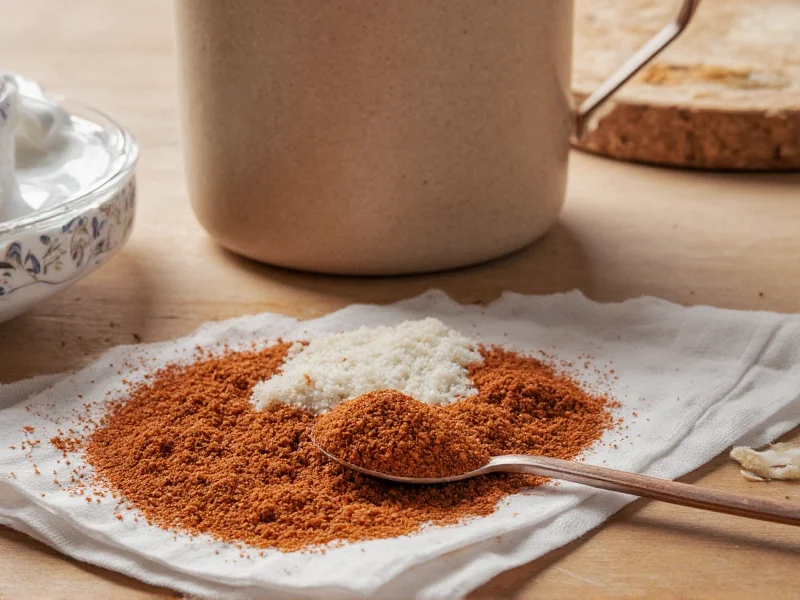Understanding Mace: The Spice That's More Than Just Nutmeg's Companion
Mace seasoning often lives in the shadow of its more famous cousin, nutmeg, but this distinctive spice deserves recognition in its own right. While both come from the same tropical fruit (Myristica fragrans), mace represents the vibrant outer membrane that wraps around the nutmeg seed. When harvested, this membrane is carefully removed, flattened, and dried until it transforms from bright red to a distinctive amber-orange hue.
The Botanical Relationship: Mace and Nutmeg Explained
Understanding the connection between mace and nutmeg begins with the fruit of the Myristica fragrans tree. This evergreen tree, native to the Banda Islands in Indonesia, produces a peach-like fruit that splits open when ripe to reveal:
- The hard, brown nutmeg seed at the center
- The lacy, web-like aril (mace) that surrounds the seed
When processed, one nutmeg fruit yields one nutmeg seed and one piece of mace. Despite their shared origin, these spices develop distinct flavor profiles due to differences in chemical composition. Mace contains higher concentrations of myristicin and elemicin, contributing to its brighter, more complex taste.
| Characteristic | Mace Seasoning | Nutmeg |
|---|---|---|
| Origin on Fruit | Outer aril (covering) | Inner seed |
| Color | Amber-orange to golden | Brown |
| Flavor Profile | Citrusy, floral, delicate warmth | Earthy, woody, stronger warmth |
| Intensity | More subtle (use 25-30% more) | Stronger (use less) |
| Best For | Light-colored dishes, delicate sauces | Hearty dishes, darker sauces |
Flavor Profile and Culinary Applications
Mace seasoning delivers a sophisticated flavor profile that combines:
- Citrus notes reminiscent of orange and lemon
- Subtle floral undertones
- Warm spice characteristics similar to cinnamon and clove
- A delicate sweetness without actual sugar content
This complex profile makes mace exceptionally versatile in the kitchen. Professional chefs often reach for mace when they want spice warmth without overwhelming other flavors. Unlike nutmeg which can dominate a dish, mace integrates seamlessly, enhancing rather than masking other ingredients.
When to Choose Mace Over Nutmeg
Understanding when to reach for mace instead of nutmeg can elevate your cooking. Consider using mace seasoning in these specific scenarios:
- Light-colored sauces and creams: Mace won't discolor pale sauces like béchamel or custards where nutmeg might create unappealing specks
- Fish and seafood dishes: Its citrus notes complement delicate seafood flavors better than nutmeg's earthiness
- White meat preparations: Chicken and turkey benefit from mace's subtle warmth without the visual distraction of nutmeg specks
- Pastries and light desserts: Mace enhances fruit-based desserts and light cakes where nutmeg might be too assertive
- Preserves and pickling: Its floral notes shine in fruit preserves and spiced vinegars
Practical Usage Guidelines for Home Cooks
When incorporating mace seasoning into your cooking, follow these evidence-based recommendations:
- Whole vs. ground: Whole blade mace retains flavor significantly longer than ground. Grate whole mace using a microplane for best results
- Measurement conversion: Use approximately 25% more mace than nutmeg when substituting (1/4 tsp nutmeg = 1/3 tsp mace)
- Addition timing: Add ground mace during the last 10-15 minutes of cooking; add whole blades early and remove before serving
- Storage: Keep whole mace blades in an airtight container away from light for up to 2 years; ground mace maintains quality for 6-12 months
Global Culinary Traditions Featuring Mace
Mace seasoning has been prized across culinary traditions for centuries:
- Indian cuisine: Essential in garam masala blends and many curry preparations, particularly in delicate kormas
- Dutch baking: Key ingredient in traditional speculaas spice mix for spiced cookies
- British cooking: Historically used in classic meat pies and savory puddings
- Caribbean dishes: Features prominently in jerk seasoning blends and festive sorrel drinks
- Middle Eastern cuisine: Adds complexity to rice dishes like maqluba and spiced meat preparations
Nutritional Profile and Potential Health Benefits
While primarily used for flavor, mace seasoning offers some nutritional components worth noting. Per teaspoon (2g) of ground mace:
- Calories: 12
- Dietary fiber: 1.3g (5% of daily value)
- Manganese: 0.2mg (9% of daily value)
- Iron: 0.4mg (2% of daily value)
- Calcium: 20mg (2% of daily value)
Research suggests mace contains compounds with potential antioxidant and anti-inflammatory properties, though these benefits are modest given typical usage amounts. Like most spices, mace works best as part of a varied, balanced diet rather than as a targeted health supplement.
Selecting Quality Mace: What to Look For
When purchasing mace seasoning, consider these quality indicators:
- Color: High-quality mace displays a vibrant amber-orange hue; dull brown indicates age or poor processing
- Whole blades: Look for intact, flexible blades without excessive breakage; brittle pieces suggest age
- Aroma: Fresh mace should have a pronounced citrus-spice fragrance when crushed
- Origin: Grenadian mace is often considered superior, though Indonesian and Sri Lankan varieties are also excellent
- Organic certification: Particularly valuable for mace since it's the outer layer of the fruit and may retain more pesticide residues
Simple Recipe Applications for Mace Seasoning
Ready to use your mace? Try these straightforward applications:
- Enhanced scrambled eggs: Add a pinch of ground mace to eggs with black pepper for a sophisticated breakfast
- Apple pie upgrade: Replace half the nutmeg in your favorite apple pie recipe with mace for brighter fruit flavors
- Creamy pasta sauce: Add a whole blade of mace to your béchamel sauce, removing it before serving
- Spiced simple syrup: Simmer 1 cup water, 1 cup sugar, and 2 mace blades for unique cocktail applications
- Roasted vegetables: Toss root vegetables with olive oil, salt, and a pinch of mace before roasting











 浙公网安备
33010002000092号
浙公网安备
33010002000092号 浙B2-20120091-4
浙B2-20120091-4